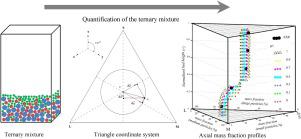Particuology ( IF 4.1 ) Pub Date : 2020-05-23 , DOI: 10.1016/j.partic.2020.03.004 Mojtaba Rasteh , Alireza Bahramian , Goodarz Ahmadi

|
The segregation behavior of a mixture of silica-coated titanium dioxide (TiO2) particles of three different sizes in a pseudo two-dimensional fluidized bed was studied experimentally by the freeze–sieving method and numerically by the multi-fluid model (MFM). Three-dimensional computational fluid dynamics (CFD) simulations were carried out to evaluate the effects of the solid wall boundary conditions on particle segregation in terms of specularity and particle–wall restitution coefficients. The quantitative indexes of segregation tendency and segregation degree were used to determine the axial segregation of the mixture in triangular coordinates. The simulation results revealed that the axial segregation increased with the specularity coefficient, whereas the particle–wall restitution coefficient had a minor effect on axial segregation. Comparison of the simulation results with experimental data showed that the appropriate value of the specularity coefficient used in the CFD model depended on superficial gas velocity. The study of the effects of superficial gas velocity on segregation behavior demonstrated that the greatest segregation was obtained at minimum fluidization velocity and the segregation decreased as the gas velocity gradually increased.
中文翻译:

二氧化钛颗粒三元混合物在拟二维流化床中的偏析行为
二氧化硅包覆的二氧化钛(TiO 2)混合物的偏析行为)通过冷冻筛分法,通过多流体模型(MFM)数值研究了在伪二维流化床中三种不同尺寸的颗粒。进行了三维计算流体动力学(CFD)模拟,以从镜面反射率和颗粒壁恢复系数方面评估了固体壁边界条件对颗粒分离的影响。使用偏析趋势和偏析度的定量指标来确定混合物在三角坐标系中的轴向偏析。仿真结果表明,轴向偏析随着镜面反射系数的增加而增加,而颗粒-壁回复系数对轴向偏析的影响较小。仿真结果与实验数据的比较表明,CFD模型中使用的镜面反射系数的适当值取决于表面气体速度。对表观气体速度对偏析行为影响的研究表明,在最小流化速度下可获得最大的偏析,并且随着气体速度逐渐增加,偏析减少。











































 京公网安备 11010802027423号
京公网安备 11010802027423号